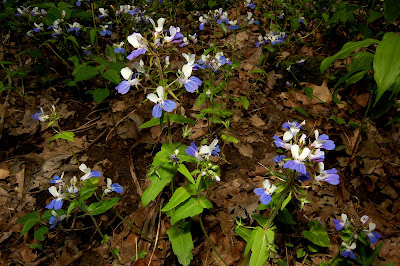The strange little ferns shown below are members of Ophioglossaceae, the Adder's Tongue Fern family. Many are highly variable and subject to much disagreement in nomenclature and identification.
Botrychium simplex?, Least Grape Fern
This very tiny fern was growing in thin woods along the edge of an open marsh. It is possibly Botrychium simplex, or conceivably could be a diminutive B. matricariaefolium (see below). Both species are highly variable. I am led to call it B. simplex mainly because of the absence of a midrib on the pinnae (lateral lobes of the blade).

Botrychium matricariaefolium, Daisyleaf Grape Fern
The specific epithet is also spelled matricariifolium. This curious little fern seems to be expanding its range in recent years. Once rare, it is becoming somewhat frequent in wooded areas. It has a special affinity for young Red Maple thickets that develop in formerly open areas. Its morphology is outlandishly variable.

Botrychium virginianum, Rattlesnake Fern
This is one of the few Botrychium ferns that is easy to identify. It's leaves are thin where most other Botrychiums are thick and leathery. It's blade is always triangular in outline, and it is much larger than the other Botrychiums. It is common in a variety of quality woodlands and even degraded woodlands. The reason for the common name is unclear.

Botrychium dissectum var. obliquum?, Oblique Grape Fern
This fern is somewhat common in northern Indiana, emerging in late summer or fall and persisting through the winter. Botrychium dissectum and its varieties are extremely variable; their nomenclature is caught in a never ending flux. I would be very surprised to find 3 or 4 authors who treat them the same, hence the question mark.

Ophioglossum vulgatum, Southern Adder's Tongue Fern
This small fern was photographed in deep shade in a hilly forest between the Salamonie and Wabash Rivers in central Indiana. The colony was discovered by Scott Namestnik.

Ophioglossum pusillum, Northern Adder's Tongue Fern
This inconspicuous little plant is somewhat easy to find in quality wet prairie remnants. It has a special affinity for the shade beneath large masses of Cinnamon Fern and Royal Fern in wet sand prairie. It is worth noting that it was an associate of the remarkable Thismia americana on the south side of Chicago.
















 One of the best experiences for a botanist or a student of the flora is to visit a new site and learn lots of new species This is what happened on Sunday, and it was profoundly enjoyable!
One of the best experiences for a botanist or a student of the flora is to visit a new site and learn lots of new species This is what happened on Sunday, and it was profoundly enjoyable!



















